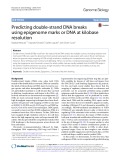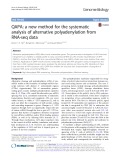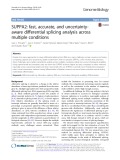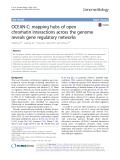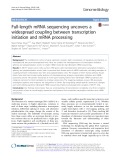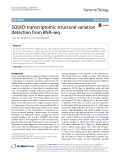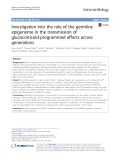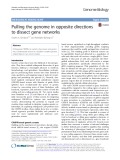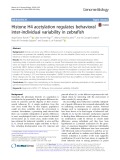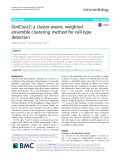
Genome Biology
-
The biological importance and varied metabolic capabilities of specific microbial strains have long been established in the scientific community. Strains have, in the past, been largely defined and characterized based on microbial isolates.
 16p
16p  vibransone
vibransone
 28-03-2024
28-03-2024
 7
7
 1
1
 Download
Download
-
3′ Untranslated regions (3' UTRs) length is regulated in relation to cellular state. To uncover key regulators of poly(A) site use in specific conditions, we have developed PAQR, a method for quantifying poly(A) site use from RNA sequencing data and KAPAC, an approach that infers activities of oligomeric sequence motifs on poly(A) site choice.
 17p
17p  vimichaelfaraday
vimichaelfaraday
 25-03-2022
25-03-2022
 13
13
 2
2
 Download
Download
-
Double-strand breaks (DSBs) result from the attack of both DNA strands by multiple sources, including radiation and chemicals. DSBs can cause the abnormal chromosomal rearrangements associated with cancer. Recent techniques allow the genome-wide mapping of DSBs at high resolution, enabling the comprehensive study of their origins.
 14p
14p  vimichaelfaraday
vimichaelfaraday
 25-03-2022
25-03-2022
 17
17
 1
1
 Download
Download
-
Ovarian cancer constitutes one of the most lethal gynecologic malignancies for females. Currently, early detection strategies and therapeutic options for ovarian cancer are far from satisfactory, leading to high diagnosis rates at late stages and disease relapses. New avenues of therapy are needed that target key processes in ovarian cancer progression.
 20p
20p  vimichaelfaraday
vimichaelfaraday
 25-03-2022
25-03-2022
 15
15
 1
1
 Download
Download
-
CRISPR/dCas9 binds precisely to defined genomic sequences through targeting of guide RNA (gRNA) sequences. In vivo imaging of genomic loci can be achieved by recruiting fluorescent proteins using either dCas9 or gRNA. We thoroughly validate and compare the effectiveness and specificity of several dCas9/gRNA genome labeling systems.
 10p
10p  vimichaelfaraday
vimichaelfaraday
 25-03-2022
25-03-2022
 24
24
 1
1
 Download
Download
-
Alternative polyadenylation (APA) affects most mammalian genes. The genome-wide investigation of APA has been hampered by an inability to reliably profile it using conventional RNA-seq. We describe ‘Quantification of APA’ (QAPA), a method that infers APA from conventional RNA-seq data.
 18p
18p  vimichaelfaraday
vimichaelfaraday
 25-03-2022
25-03-2022
 17
17
 1
1
 Download
Download
-
Organogenesis is crucial for proper organ formation during mammalian embryonic development. However, the similarities and shared features between different organs and the cellular heterogeneity during this process at single-cell resolution remain elusive.
 20p
20p  vimichaelfaraday
vimichaelfaraday
 25-03-2022
25-03-2022
 18
18
 1
1
 Download
Download
-
Despite the many approaches to study differential splicing from RNA-seq, many challenges remain unsolved, including computing capacity and sequencing depth requirements. Here we present SUPPA2, a new method that addresses these challenges, and enables streamlined analysis across multiple conditions taking into account biological variability.
 11p
11p  vimichaelfaraday
vimichaelfaraday
 25-03-2022
25-03-2022
 20
20
 1
1
 Download
Download
-
Compared to RNA-sequencing transcript differential analysis, gene-level differential expression analysis is more robust and experimentally actionable. However, the use of gene counts for statistical analysis can mask transcript-level dynamics. We demonstrate that ‘analysis first, aggregation second,’ where the p values derived from transcript analysis are aggregated to obtain gene-level results, increase sensitivity and accuracy.
 11p
11p  vimichaelfaraday
vimichaelfaraday
 25-03-2022
25-03-2022
 13
13
 3
3
 Download
Download
-
We develop a method called open chromatin enrichment and network Hi-C (OCEAN-C) for antibody-independent mapping of global open chromatin interactions. By integrating FAIRE-seq and Hi-C, OCEAN-C detects open chromatin interactions enriched by active cis-regulatory elements.
 14p
14p  vimichaelfaraday
vimichaelfaraday
 25-03-2022
25-03-2022
 12
12
 3
3
 Download
Download
-
The multifaceted control of gene expression requires tight coordination of regulatory mechanisms at transcriptional and post-transcriptional level. Here, we studied the interdependence of transcription initiation, splicing and polyadenylation events on single mRNA molecules by full-length mRNA sequencing.
 18p
18p  vimichaelfaraday
vimichaelfaraday
 25-03-2022
25-03-2022
 16
16
 2
2
 Download
Download
-
Glioma stem cells (GSCs) are a subpopulation of stem-like cells that contribute to glioblastoma (GBM) aggressiveness, recurrence, and resistance to radiation and chemotherapy. Therapeutically targeting the GSC population may improve patient survival, but unique vulnerabilities need to be identified.
 25p
25p  vimichaelfaraday
vimichaelfaraday
 25-03-2022
25-03-2022
 23
23
 1
1
 Download
Download
-
Transcripts are frequently modified by structural variations, which lead to fused transcripts of either multiple genes, known as a fusion gene, or a gene and a previously non-transcribed sequence. Detecting these modifications, called transcriptomic structural variations (TSVs), especially in cancer tumor sequencing, is an important and challenging computational problem.
 16p
16p  vimichaelfaraday
vimichaelfaraday
 25-03-2022
25-03-2022
 16
16
 1
1
 Download
Download
-
Early life exposure to adverse environments affects cardiovascular and metabolic systems in the offspring. These programmed effects are transmissible to a second generation through both male and female lines, suggesting germline transmission. We have previously shown that prenatal overexposure to the synthetic glucocorticoid dexamethasone (Dex) in rats reduces birth weight in the first generation (F1), a phenotype which is transmitted to a second generation (F2), particularly through the male line.
 15p
15p  vimichaelfaraday
vimichaelfaraday
 25-03-2022
25-03-2022
 15
15
 1
1
 Download
Download
-
Genetic screens have been the lifeblood of forward genetics. They have enabled widespread discoveries of gene function, leading to meaningful advances in medicine, biotechnology, and agriculture. Nevertheless, technologies for performing these screens have been limited by scale, specificity, and targeting range of tools for investigating and perturbing the genome.
 4p
4p  vimichaelfaraday
vimichaelfaraday
 25-03-2022
25-03-2022
 13
13
 1
1
 Download
Download
-
Human pluripotent stem cells (hPSCs) provide powerful models for studying cellular differentiations and unlimited sources of cells for regenerative medicine. However, a comprehensive single-cell level differentiation roadmap for hPSCs has not been achieved.
 19p
19p  vimichaelfaraday
vimichaelfaraday
 25-03-2022
25-03-2022
 14
14
 1
1
 Download
Download
-
Animals can show very different behaviors even in isogenic populations, but the underlying mechanisms to generate this variability remain elusive. We use the zebrafish (Danio rerio) as a model to test the influence of histone modifications on behavior.
 21p
21p  vimichaelfaraday
vimichaelfaraday
 25-03-2022
25-03-2022
 13
13
 1
1
 Download
Download
-
A new study reveals comprehensive and unique epigenetic properties of glioma stem cells, leading to novel molecular insights and therapeutic potentials toward glioblastoma multiforme treatment.
 3p
3p  vimichaelfaraday
vimichaelfaraday
 25-03-2022
25-03-2022
 11
11
 1
1
 Download
Download
-
Single-cell analysis is a powerful tool for dissecting the cellular composition within a tissue or organ. However, it remains difficult to detect rare and common cell types at the same time. Here, we present a new computational method, GiniClust2, to overcome this challenge.
 13p
13p  vimichaelfaraday
vimichaelfaraday
 25-03-2022
25-03-2022
 11
11
 1
1
 Download
Download
-
Recent sequencing technologies enable joint quantification of promoters and their enhancer regions, allowing inference of enhancer–promoter links. We show that current enhancer–promoter inference methods produce a high rate of false positive links. We introduce FOCS, a new inference method, and by benchmarking against ChIAPET, HiChIP, and eQTL data show that it results in lower false discovery rates and at the same time higher inference power.
 14p
14p  vimichaelfaraday
vimichaelfaraday
 25-03-2022
25-03-2022
 14
14
 1
1
 Download
Download
CHỦ ĐỀ BẠN MUỐN TÌM










